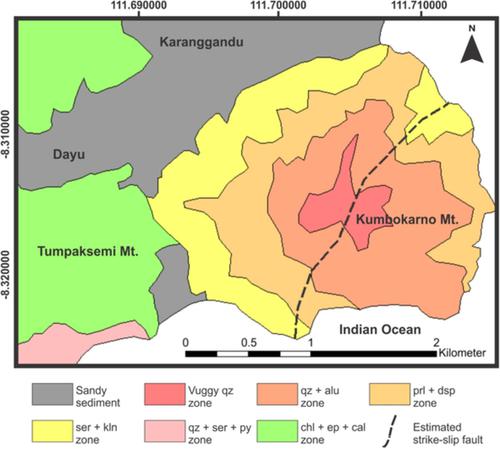印度尼西亚东爪哇省Trenggalek地区Kumbokarno远景区高硫化热液—斑岩转变:矿物学、流体包裹体和硫同位素研究的限制
IF 0.8
4区 地球科学
Q3 GEOLOGY
引用次数: 0
摘要
在印度尼西亚东爪哇的Kumbokarno远景区发现了高硫化热液—斑岩转变的迹象。该区远景由两个中中新世侵入岩组成,具有调性和闪长岩成分。主寄主闪长岩主要经历泥质、超前泥质和溶洞石英蚀变,并置闪长岩主要经历外围丙质蚀变。研究区内存在块状石英、梳状石英和网状石英三种类型的矿脉。此外,以针铁矿和赤铁矿为代表的表生蚀变与热液蚀变和成矿作用普遍叠加。三种石英脉流体包裹体岩石学和显微测温分析将原生流体包裹体分为两组,即由蒸汽(30 vol%) -液体(70 vol%)组成的V30组和由蒸汽(30 vol%) -岩盐(30 vol%) -液体(40 vol%)组成的V30H组。两组的均质温度在350 ~ 480℃范围内相似,但V30H组的盐度(35 ~ 50 wt% NaCl eq.)明显高于V30组(10 ~ 20 wt% NaCl eq.)。从脉型上看,块状石英脉均一温度最高,其次为梳状石英脉,最后为网状石英脉。明矾石的存在及其硫同位素组成δ34S = 19.6 (σ = 2.1‰)表明热液中存在酸性pH和SO42−。展望区为侵入中心岩浆-热液系统,反映斑岩-浅成热液转变。流体包裹体均质温度高达480°C,盐度高达50 wt% NaCl当量,也支持斑岩向高硫化浅热液矿化转变。两种不同类型原生流体包裹体的存在表明岩浆发生沸腾过程,将原始岩浆分离为液相和气相。此外,这种液体还经历了稀释和与大气水混合的过程。这两种流体的运移可能与晚期泥质-泥质蚀变晕的形成无关,因为石英脉穿过了这一蚀变。该远景后来经历了剧烈的风化作用,使大部分硫化物变成氧化铁和氢氧化物。少量的铜和少量的金被检测到,特别是在氧化铁和氢氧化物中,它们具有胶状和叶片状的纹理。Kumbokarno远景区证明了印尼南部山弧斑岩矿床的高硫化潜力。本文章由计算机程序翻译,如有差异,请以英文原文为准。

High‐sulfidation epithermal–porphyry transition in the Kumbokarno Prospect, Trenggalek district, East Java, Indonesia: Constraints from mineralogy, fluid inclusion, and sulfur isotope studies
An indication of high‐sulfidation epithermal–porphyry transition was observed in the Kumbokarno prospect, East Java, Indonesia. The prospect is composed of two Middle Miocene intrusions with tonalitic and dioritic compositions. Tonalite, the main host‐rock was subjected to argillic, advanced argillic, and vuggy quartz alteration, whereas the juxtaposing diorite was subjected to peripheral propylitic alteration. Three types of vein exist in the research area, which are massive quartz, comb quartz, and stockwork vein. In addition, supergene alteration represented by goethite and hematite pervasively superimposed both the hydrothermal alteration and mineralization. Fluid inclusion petrography and microthermometry analysis on three types of quartz veins distinguished primary fluid inclusions into two groups, that is, V30 group composed of vapor (30 vol%)–liquid (70 vol%), and the second group V30H group composed of vapor (30 vol%)–halite (30 vol%)–liquid (40 vol%). The homogenization temperatures of both the groups show a similar range of ca. 350–480°C, but the V30H group has significantly higher salinity (35–50 wt% NaCl eq.) compared to the V30 group (10–20 wt% NaCl eq.). In terms of the vein types, the massive quartz vein has the highest homogenization temperatures, followed by the comb quartz vein and lastly the stockwork veins. The presence of alunite and its sulfur isotope compositions, δ34S = 19.6 (σ = 2.1‰), indicate acidic pH and presence of SO42− in the hydrothermal fluids. The prospect is an intrusion‐centered magmatic‐hydrothermal system reflecting the porphyry‐epithermal transition. The fluid inclusions with high homogenization temperatures up to 480°C and high salinity up to 50 wt% NaCl eq. also support the transition of porphyry to high‐sulfidation epithermal mineralization. The presence of two different types of primary fluid inclusions suggests that boiling process occurred and separated the original magmatic fluid into the liquid and vapor phases. More, this fluid underwent dilution and mixing with meteoric waters. The migration of both the fluids were likely unrelated to the formation of the advanced argillic–argillic alteration halo because the quartz veins cut across this alteration. The prospect was later subjected to intensive weathering process that altered most of the sulfides into iron oxides and hydroxides. Small amounts of copper and minor gold were detected, especially in the iron oxides and hydroxides ones with colloform and bladed textures. The Kumbokarno prospect evidences the potential for high‐sulfidation to porphyry deposits at the Southern Mountain Arc, Indonesia.
求助全文
通过发布文献求助,成功后即可免费获取论文全文。
去求助
来源期刊

Resource Geology
地学-地质学
CiteScore
2.30
自引率
14.30%
发文量
18
审稿时长
12 months
期刊介绍:
Resource Geology is an international journal focusing on economic geology, geochemistry and environmental geology. Its purpose is to contribute to the promotion of earth sciences related to metallic and non-metallic mineral deposits mainly in Asia, Oceania and the Circum-Pacific region, although other parts of the world are also considered.
Launched in 1998 by the Society for Resource Geology, the journal is published quarterly in English, making it more accessible to the international geological community. The journal publishes high quality papers of interest to those engaged in research and exploration of mineral deposits.
 求助内容:
求助内容: 应助结果提醒方式:
应助结果提醒方式:


